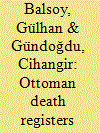|
|
|
Sort Order |
|
|
|
Items / Page
|
|
|
|
|
|
|
| Srl | Item |
| 1 |
ID:
164910


|
|
|
|
|
| Summary/Abstract |
This article is on one of the longest-lived medical institutions of the Ottoman Empire, the Haseki Hospital. I will try to glimpse to the daily workings of the Haseki Hospital and the transformations it underwent in terms of the services it offered, its patients, its social functions, and its relevance for the urban lives of the destitute women of the empire for the period between the 1830s and 1893. During that period, the Haseki Women's Hospital was an institution hosting poor and destitute women as well as pregnant, ill, feeble-minded, convicted women, widows, prostitutes, and orphans. Although it has been called a hospital, it has been used as a women's hospital, lying-in clinic, madness asylum, widow's house, orphanage, and a women's prison. I submit that the Haseki Women's Hospital fulfilled a dual purpose by combining social relief services with medical care for female patients. Besides being a locus of medicine, the hospital was also a site where women in the margins were confined and isolated, but also received care otherwise denied to them. Along these lines, this article searches the vulnerability of the destitute women of nineteenth century Istanbul.
|
|
|
|
|
|
|
|
|
|
|
|
|
|
|
|
| 2 |
ID:
177694


|
|
|
|
|
| Summary/Abstract |
This article presents an analysis of the first recognisably modern-style death registers in the Ottoman Empire. These were produced, in 1838–9, as a result of the state’s reaction to the cholera pandemic of 1831. This article shows how these registers were designed and structured, how they differed to those that preceded and came after them and so occupied a key point in the transition to the medicalisation of death and the import of Western-style statistical analysis. The article demonstrates how these registers offer details that can be used to build a picture of the social, economic and demographic profile of death in Istanbul in these years.
|
|
|
|
|
|
|
|
|
|
|
|
|
|
|
|
|
|
|
|
|